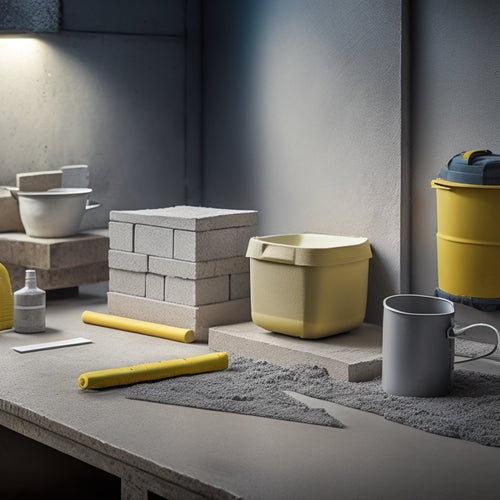
Top 5 Concrete Repair Tools for Foundation Fixes
Share
When tackling foundation repairs, you'll need the right tools to guarantee a lasting fix. Your top 5 must-haves are foundation crack injection guns for filling cracks with epoxy or polyurethane-based materials, epoxy resin applicator tools for precise application and mixing, concrete surface preparation kits to create a strong bond between concrete and repair material, polyurethane foam injectors for filling gaps and voids, and crack chasing saws for controlled repair. With these tools, you'll be well-equipped to handle common foundation fixes, and by understanding their specific uses and techniques, you'll be able to tackle even the most complex repairs with confidence.
Key Takeaways
• Foundation crack injection guns are essential for filling cracks in concrete foundations, walls, and floors with epoxy or polyurethane-based materials.
• Epoxy resin applicator tools, including mixing sticks, applicator guns, and injection nozzles, ensure precise application and thorough mixing of epoxy resin.
• Concrete surface preparation kits, featuring wire brushes, scrubbers, and cleaning solutions, are vital for creating a strong bond between concrete and repair material.
• Polyurethane foam injectors dispense expanding foam that hardens for a durable bond, ideal for filling gaps and voids in concrete structures.
• Crack chasing saws, equipped with diamond blades, are designed to cut along the crack's trajectory for controlled repair, minimizing dust and ensuring effective concrete cutting.
Foundation Crack Injection Guns
You'll need a reliable foundation crack injection gun to effectively fill cracks in concrete foundations, walls, and floors with epoxy or polyurethane-based materials. This essential tool enables you to perform a thorough foundation crack assessment, identifying the severity and extent of the damage.
By selecting the appropriate injection material type, you can guarantee a successful repair. Epoxy-based materials are ideal for structural repairs, while polyurethane-based materials are better suited for non-structural repairs.
When choosing a foundation crack injection gun, consider the pressure capacity, material flow rate, and ergonomic design. A high-pressure gun can deliver material deep into the crack, while a low-pressure gun is better suited for smaller cracks.
The material flow rate will determine how quickly you can fill the crack. An ergonomic design will reduce fatigue and improve control during the injection process.
Epoxy Resin Applicator Tools
After selecting the right injection material and gun, it's time to turn your attention to epoxy resin applicator tools, which play a significant role in guaranteeing a strong, long-lasting bond between the concrete and the repair material. These tools allow you to apply epoxy resin with precision and control, enabling you to achieve the best results. When choosing an epoxy resin applicator tool, consider the specific requirements of your project, including the type of epoxy resin you're using and the size of the area to be repaired.
Here are some common epoxy resin applicator tools, their benefits, and techniques for use:
| Tool | Benefit | Technique |
|---|---|---|
| Mixing sticks | Guarantees thorough mixing of epoxy resin | Mix in a circular motion for 2-3 minutes |
| Applicator guns | Allows for precise application of epoxy resin | Hold gun at a 45-degree angle, apply steady pressure |
| Injection nozzles | Enables targeted application of epoxy resin | Insert nozzle into crack or void, apply gentle pressure |
| Spatulas | Useful for applying epoxy resin to large areas | Apply thin, even layers, allowing each layer to set before applying the next |
| Brushes | Ideal for applying epoxy resin to small, intricate areas | Use gentle, sweeping strokes to apply thin, even layers |
Concrete Surface Preparation Kits
Concrete surface preparation kits are vital for guaranteeing a strong bond between the concrete and the repair material, as they allow you to thoroughly clean and prepare the surface for the application of epoxy resin.
When it comes to concrete repair, surface preparation is a significant step that can't be overlooked. A well-prepared surface guarantees a strong, durable bond between the old concrete and the new repair material.
These kits usually include a combination of tools and materials, such as wire brushes, scrubbers, and cleaning solutions, designed to remove dirt, oil, and other contaminants that can compromise the bond.
By using a concrete surface preparation kit, you'll be able to employ advanced surface preparation techniques, such as mechanical abrasion and chemical cleaning, to create a surface that's ready for repair.
This is a vital step in achieving a successful repair, and it's a key component of any concrete repair essentials checklist.
Polyurethane Foam Injectors
When preparing to fill gaps and voids in concrete structures, polyurethane foam injectors become a crucial tool in your arsenal, allowing you to accurately dispense expanding foam that hardens to form a strong, durable bond.
With polyurethane foam injectors, you can guarantee precise foam application, which is critical for achieving ideal results. The polyurethane benefits are numerous, including its ability to expand up to 20 times its original volume, allowing it to fill even the smallest voids and gaps.
To get the most out of your polyurethane foam injector, it's important to understand the correct foam application techniques. This includes confirming the surface is clean and dry, applying the foam in a consistent, controlled manner, and allowing it to fully expand and harden before proceeding with further repairs.
Crack Chasing Saws
You'll need a crack chasing saw to precisely cut along the crack's trajectory, creating a clean, controlled path for subsequent repair materials. This specialized saw is designed to remove deteriorated concrete and create a uniform surface for crack repair. When selecting a crack chasing saw, consider the blade type, as diamond blades are ideal for concrete cutting. Verify the saw has adjustable cutting depths and a vacuum attachment to minimize dust and debris.
To master saw techniques for crack repair, practice cutting along the crack's length, maintaining a consistent speed and applying gentle to moderate pressure. Avoid applying excessive pressure, which can cause further damage to the surrounding concrete.
For tighter spaces, use a saw with a smaller blade diameter or an oscillating multi-tool with a concrete cutting attachment. By employing these saw techniques, you'll be able to create a precise, controlled cut, setting the stage for a successful crack repair.
With the right saw and techniques, you'll achieve a durable, long-lasting repair that restores the integrity of the foundation.
Frequently Asked Questions
Can I Rent Concrete Repair Tools Instead of Buying Them?
When considering concrete repair, you're wise to weigh your options.
Renting tools can be a cost-effective alternative to buying, especially if you're tackling a one-time project.
Before making a decision, you'll want to do a cost comparison, factoring in rental fees, equipment availability, and the duration of your project.
Assess tool availability, too, ensuring the rental options meet your specific repair needs.
How Long Does It Take to Learn Concrete Repair Techniques?
As you commence the journey to master concrete repair techniques, think of yourself as a skilled sailor steering through uncharted waters.
You'll encounter learning curves that'll test your resolve, but with dedication, you'll chart a course to success.
The repair techniques you'll learn are like intricate knots - they require patience and practice to master.
Allocate several weeks to months to develop a solid foundation, and soon you'll be tying those knots with ease, repairing concrete like a pro.
Are Concrete Repair Tools Suitable for DIY Projects?
When tackling a DIY project, you'll want to carefully consider whether concrete repair tools are suitable for your needs.
Remember, tool selection is essential; choose the right ones for your specific project requirements.
For instance, if you're dealing with hairline cracks, a precision injection gun might be the way to go.
On the other hand, larger repairs may require a heavy-duty mixer or drill.
Can I Use Concrete Repair Tools on Walls and Floors?
When tackling concrete wall repairs or floor crack solutions, you'll need to assess the damage before deciding which tools to use.
For walls, you'll typically require a drill, mixing paddle, and trowel to apply epoxy or polyurethane-based products.
For floor crack solutions, a grinder or scarifier may be necessary to prep the surface, followed by a self-leveling compound and a finishing trowel.
You'll need to choose the right tools for the specific job to guarantee a durable, long-lasting repair.
Do Concrete Repair Tools Come With a Manufacturer's Warranty?
As you navigate the complex landscape of concrete repair, you're wise to wonder if the tools you're investing in will stand the test of time.
Think of a warranty as a shield, protecting you from defects and malfunctions. When you buy a tool, you'll typically find warranty coverage ranging from 1-5 years.
To maximize this protection, prioritize tool maintenance: clean and store them properly, and perform regular checks to guarantee peak performance.
Conclusion
You've made it to the final step of your foundation repair journey, and with these top 5 concrete repair tools, you're well-equipped to tackle even the toughest cracks.
Like a surgeon with a scalpel, you'll be precision-cutting your way to a solid foundation.
Remember, a strong foundation is the backbone of a safe and stable structure, so don't compromise on quality tools.
With these essentials, you'll be building on solid ground.
Related Posts
-

What Tools Do I Need for Concrete Block Laying
You'll need a thorough set of tools to guarantee accurate, efficient, and professional concrete block laying. Essenti...
-

Free Design Tools for Concrete House Planning
You can kick-start your concrete house planning project without breaking the bank, as there are several free design t...
-

10 Best Tools for Sealed Concrete Finishing Success
When it comes to sealed concrete finishing success, you need a robust arsenal of specialized tools. Start with essent...


